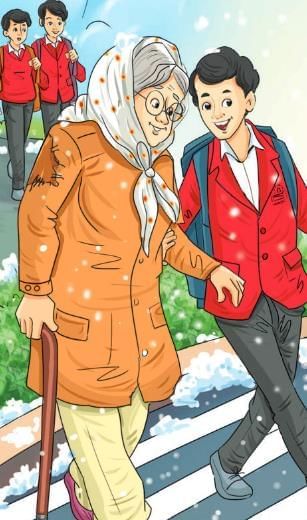Short and Long Answer Questions: Somebody's Mother | English Poorvi Class 8 - New NCERT PDF Download
Short Answer Questions
Q1. Describe the condition of the old woman in the poem.
Ans: The old woman in the poem was old, ragged, and grey. She was weak, with trembling and slow feet, bent with the chill of the winter day. She stood alone at the crossing, anxious and helpless, waiting for someone to help her cross the slippery street. Her appearance showed poverty, old age, and helplessness, which made her situation even more pitiful.
Q2. How did the people on the street treat the old woman?
Ans: The people on the street completely ignored the old woman. Although she looked helpless and anxious, no one cared to stop or offer her a helping hand. They were busy in their own lives and walked past her as if she did not exist. This shows the selfish and indifferent attitude of society toward the weak and old.
Q3. What was the attitude of the boys coming out of school?
Ans: The boys were cheerful, happy, and excited after school was over. They were shouting, laughing, and playing in the snow like a flock of sheep. However, they were careless and did not notice the old woman standing at the crossing. None of them came forward to help her except one noble-hearted boy.
Q4. What did the young boy do for the old woman?
Ans: The young boy, unlike the others, noticed the old woman and felt compassion for her. He gently whispered to her that he would help her cross the road if she wished. He offered his strong arm and carefully guided her trembling feet across the slippery street, making sure she was safe. This act of kindness made both the boy and the woman happy.
Q5. Why did the boy decide to help the old woman?
Ans: The boy decided to help the woman because he felt empathy. He thought of her as “somebody’s mother” and imagined that one day his own mother could also grow old, poor, and helpless. He hoped that if such a time came, some kind-hearted person would help his mother too. This thought made him act selflessly and help the woman.

Long Answer Questions
Q1. Narrate the incident of the old woman at the crossing as described in the poem.
Ans: In the poem, an old woman stood at a crossing on a cold winter day. She was poor, ragged, grey-haired, and bent with age. The street was slippery with snow, and her steps were weak and trembling. She waited anxiously for someone to help her cross, but people passing by ignored her. Even the group of cheerful boys coming out of school hurried past without noticing her. At last, one kind-hearted boy stopped, spoke gently to her, and offered his arm. He carefully guided her across the road, making sure she was safe. This incident highlights how a small act of kindness can make a big difference in someone’s life.
Q2. What lesson does the poem Somebody’s Mother teach us?
Ans: The poem teaches the importance of kindness, empathy, and respect for the elderly. The old woman was ignored by everyone, but one boy stopped to help her. He realized that she was “somebody’s mother” and thought of his own mother in her place. His act of compassion shows that we should always care for those who are weak, helpless, or old. It also reminds us that the kindness we show today may return to us in the future. The old woman’s prayer at the end shows her gratitude and proves that even small good deeds are always valued. The poem inspires us to be thoughtful, caring, and responsible members of society.
|
60 videos|520 docs|57 tests
|
FAQs on Short and Long Answer Questions: Somebody's Mother - English Poorvi Class 8 - New NCERT
| 1. What is the central theme of the poem "Somebody's Mother"? |  |
| 2. How does the poem depict the relationship between a mother and her child? |  |
| 3. What literary devices are used in "Somebody's Mother"? |  |
| 4. What message does the poem convey about aging and society's perception of the elderly? |  |
| 5. How does the poem encourage readers to reflect on their own lives and relationships? |  |
















